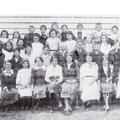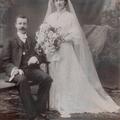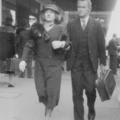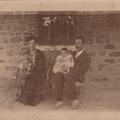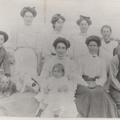Pidgeon, Mr Percival Joseph Fernance
Percival Joseph was the second of eight children born, on 13 July 1875, to John and Margaret Pidgeon. He married in 1905 whilst teaching at Jerangle. Percival died on 13th September 1970 at the age of 95. The following story of an aspect of his teaching career is compiled from a variety of sources:
"To lose one school may be regarded as a misfortune; to lose four looks like carelessness." (with apologies to Oscar Wilde)
Percival Joseph Pidgeon was the teacher in charge of the bush school at Currawarna, in the Wagga district, when in November 1900, it was destroyed by fire. The loss of schools to flames was not altogether uncommon at that time. In addition to bushfires, tramps were recognised as a significant risk, as they would, if able, take shelter inside school buildings and boil a billy.
The Sydney Morning Herald reported the fire in the following terms:
"Mr. Pidgeon, schoolmaster, reported to Inspector Smith this morning that the Currawarna Public School, 20 miles from Wagga, had been totally destroyed by fire. The cause of the fire is not known. At 5.15 am this morning the school was seen to be in flames. It was a wooden building, and was erected about four months ago. The matter has been reported to the coroner, who has deferred action pending the police report" [SMH 28 November 1900].
The coronial enquiry and verdict were reported a few weeks later by the Wagga Wagga Express:
"An Inquest concerning the fire at Currawarna public school which was burnt down early on Tuesday last was held at the Commercial Hotel Currawarna on Saturday before the acting Coroner Mr. Geo. Martin P.H. and a jury of five. Evidence was given by Mr. Percival Pidgeon the school master, Peter Keirin, the boy who locked up the school, and Michael Keirin, the father of the latter witness, who was tbe first to raise tbe alarm of fire.
The evidence was in the main in accordance with the particulars already publicised. Michael Keirin in his evidence stated that when be observed the fire he thought be saw the figure of a man inside the school fence, at the far side of the building who went towards Narrandera. This was the first time be had mentioned tbe matter. After hearing the evidence the following verdict was returned. 'We find that tbe public school premises at Currawarna were destroyed by fire on tbe morning of the 27th November 1900, but how the fire originated, whether accidentally or otherwise, the evidence adduced does not enable us to say". [Wagga Wagga Express,Tuesday 4 December 1900]
Pidgeon was apparently convinced that the fire had been the work of tramps.
A few years later Pidgeon moved to Jerangle in the Bredbo district, south of Michelago, and the story of his time there is told in 'A history of the Jerangle Public School and district'[Jerangle, 1992]:
"In 1903, after 9 years in charge of the half-time schools at Jerangle and Celeys Creek, Ernest Chave finally got his long sought-after transfer. His replacement stayed about a year before resigning, rather hurriedly under a cloud, and was replaced by Percival Pidgeon, whose name must have caused some secret amusement among pupils. Only a month after taking up duties, in a place where nothing much happened from one year to the next, he provided local residents with even greater entertainment, by falling off the bicycle he used for commuting between the two schools and breaking a small bone in his shoulder.
This was good news for pupils at Celeys Creek because Pidgeon could not stand the pain of riding his bike the 6 miles to Celeys Creek, but bad news for pupils at Jerangle, where he taught full-time for the few weeks it took his shoulder to heal. During this time he could not write on the blackboard and all his lessons were oral ones. This caused him organisational difficulties, because in a one-teacher school it was usual to give one group written work while dealing orally with the other.
Pidgeon had other problems, the main one........... was that on 12th January 1905 he got married. This was a few months after his appointment to the Half-time schools. The three-roomed residence which Chave had used was by 1905 in a dilapidated state. This was Pidgeon's dilemma:
"No residence is attached to either of the schools under my charge. The residence occupied by my predecessors has fallen into extreme disrepair and has been converted by the owner into a shearing shed, and there is no house now within ten miles of either school, vacant. The only available place to which I could bring my wife, is a hotel, which, though well conducted, I do not consider a fit and suitable place to bring her to. I am thus compelled to rent rooms for her at 'Kirkdale', Goulburn, for which I now pay nine shillings per week, and also rent a room for myself here".
Not surprisingly Pidgeon wanted a transfer to a place where he and his wife could live together. His local inspector was unsympathetic, pointing out to the Department that Pidgeon had married after he arrived at Jerangle and thus was 'fully aware of the circumstances in which he was placing himself.' He softened a little by suggesting that Pidgeon should be considered for a school with a teacher's residence as soon as such a vacancy occurred, but the Department kept him at Jerangle, apart from his wife for more than 18 months. [t is possible that the Department deliberately kept him at Jerangle, for reasons which will soon become clear].
Had Pidgeon been transferred when he asked, he would have missed out on a drama which unfolded some months later; or perhaps had he gone the drama may never have occurred. One Saturday morning in October 1905 Constable J Marshall, from Animbo Police Station. only a stone's throw from Jerangle school, notified Pidgeon that the Celeys Creek school building had been burnt down the previous evening. Accompanied by the constable and a tracker, Pidgeon visited the 'scene of the disaster and found the whole building and contents completely destroyed.' They looked for tracks but the wild, rainy weather of the previous night had obliterated any clues they might have hoped to find. Pidgeon had taught at the school the day of the fire and although he had not had a fire going in the schoolroom because the weather was rather warm, he had lit a fire at a distance from the school to boil water for a cup of tea, later carefully extinguishing it.
Perhaps Pidgeon had not fully extinguished this fire and later it flared up. It was a long- shot but seemed the only possible explanation for the fire. This theory was overturned a week later when, to everyone's surprise, the school building at Jerangle was also destroyed by fire. Once again Pidgeon, Constable Marshall and a tracker visited 'the scene of the crime', because by now it was obvious that the fires were no accident. They found footprints made by someone in sandshoes, 'either running or jumping over the soft part of the road,' but these were not able to be followed or identified by the tracker. Nor had anyone seen any strangers or tramps in the district; tramps were particularly suspect in cases such as these as they often sought refuge overnight in school buildings, lighting fires in the school fireplace to keep warm or cook their meals. No one could remember any ill-feeling towards the teacher, pupils attending the schools or their parents, which might cause someone to seek revenge by burning down the schools.
At an inquiry held in Little Plain Hotel the coroner concluded that the buildings were wilfully and maliciously burned down by some person or persons unknown. What else could one expect in a district which boasts a creek by the name of Strike a Light Creek?
Despite this verdict, the district inspector of schools suspected Pidgeon of the crime. His motive seemed obvious: he wanted to get out of Jerangle so that he could live with his wife and, as the Department of Education had denied him a transfer, the destruction of the school buildings would provide him with the means of escape. (It should be pointed out that in the history of Jerangle almost every teacher whoever went there, at one time or another wanted to get out.) The inspector was also convinced that Pidgeon had the opportunity.
At Celeys Creek on the afternoon of the fire, although the teacher often left school with the pupils, he remained behind, and overtook the pupils about a mile away from the school. This was very suspicious, thought the inspector, yet he knew there were many reasonable explanations for the teacher's delay this Friday afternoon: there were attendance register to complete, correspondence to be attended to, the program of lessons to be filled in, the school tidied up or the call of nature to be answered. Even the inspector could not explain how Pidgeon had managed to start the fire four or five hours after he had left the school.
At least at Jerangle the tracks found by Constable Marshall leading from the scene of the fire provided a little more substance to the inspector's suspicions. 'Sub Inspector Travers took the teacher to the spot,' explained the inspector, 'and made him make an impression with his foot beside these tracks; the police state that the tracks were similar and the teacher admits that there was not a great deal of difference between those tracks and the ones made by him.'
This evidence was flimsy and easily dismissed but there were some peculiar aspects to Pidgeon's behaviour which the inspector explained this way to his superior officer in Sydney:
"This teacher was married an 12 January 1905, and he receives rent allowance. His wife lives near Goulburn, but he is regarded as a single man in Jerangle; he has told several people that he is to be married at Christmas, and has gone so far as to invite one man at least to the wedding. He has been trying to obtain a removal from his present schools, both by written applications, and by an interview by his father at your office. A few days before the fire at Celeys Creek, he instructed a local bicycle agent to dispose of his bicycle, and he is alleged to have remarked to a resident that had Celeys Creek school been burnt down 3 months before, it would have been a good thing for him".
It is doubtful that any teacher who intended to burn down the schools would advertise it by getting rid of his bicycle and then commenting that it would have been better burnt down three months before.
Clearly none of this evidence was worth more than a glance, so the inspector turned his attention to the fact that Pidgeon had never spent more than 18 months at any of his previous seven schools, for which the Department of Education mostly paid his transfer costs. 'Now such an office is expensive to our Department,' lamented the inspector, 'and by such frequent changes he cannot be rendering his best services to the State.' While perhaps true the same could be said of literally hundreds of teachers throughout New South Wales who did not stay for long periods at schools and no one took any exception to their frequent moves. The Department decided that blame for fires at Celeys Creek and Jerangle could not be laid at any particular person's door, but on the off-chance that Pidgeon was responsible for them, it kept him at Jerangle for another year, just so that he did not get his way by burning down schools.
Percival finally left Jerangle in August 1906 to take up the position of teacher at Tallagandra, just north of the Capital Territory border, where he stayed for nearly four years. The Tallagandra school was severly damaged by fire five years after he left, in 1915, but it would be grossly unfair to suggest that Pidgeon had anything to do with this!
His next posting was to the nearby school at Sutton. Pidgeo took up duties there in June 1910. He enlisted in May 1916 in the Medical Corps and served on the Western Front, returning to Australia in March 1919, and resuming his post at Sutton in June 1919. Pidgeon also served in the Boer War, as a Trooper with 'A' Squadron of the NSW Mounted Rifles.
Four years later on 31 March 1923, the Sutton school and residence was completely destroyed by fire. As the following report in the Queanbeyan Age reveals, Pidgeon and his family were on holiday in Goulburn at the time, and suffered the severe loss of all their household and personal possessions. Nevertheless, Pidgeon now had the solemn duty of reporting to the Department for the fourth time, that the school he was in charge of had been destroyed by fire!
"Fire at Sutton
First-class Constable Thornton, of Gundaroo has reported to Mr. Coroner Gale that the public school and teacher's residence at Sutton were totally destroyed by fire last Saturday morning. The teacher, Mr. Pidgeon, was with his family in Goulburn on his holidays at the time, and prior to his departure on the 29th ultimo, left everything safe and all the premises locked up. At about 2.30 a.m. on Saturday Mrs. Murphy, a resident of Sutton, and others in the neighbour hood, heard what was thought to be a motor car roaring, but as the noise continued for some time without getting nearer, Mrs. Murphy got out of bed and saw that the school and teacher's residence were on fire. She at once gave the alarm, and roused her son Francis, who got up and ran to the scene of the fire.
He met William Smith on his way, who also had been aroused by the unusual noise. They arrived on the scene together ,and saw that the buildings were well alight. There was no other person about the fire when they arrived and finding that they could not do any good with the main dwelling, they went round the back to the kitchen, which by this time was well ablaze as was also the laundry which was just catching alight from the front buildings. They broke open the back door and saved a few articles from the bathroom and laundry, but could not enter the kitchen, which was by this time well ablaze. Murphy and Smith are of the opinion that the fire originated in one of the front rooms of the main dwelling house, and on the south-western side, as the building seemed to be nearly burnt out when they arrived there.
So far the origin of the fire seems to be a complete mystery. It is ascertained that the furniture and other effects in the dwelling house were insured for £400; but it is not yet known whether the buildings, which were the property of the Department of Public Instruction, were insured. The Coroner proposes holding an inquest into the mystery at an early date.
Our Sutton correspondent writes:-
The school and residence, which were attached, were of weather board and erected some forty years ago. Some additions of the same material had been added much more recently, and, being sheltered with trees, was an ideal home and one of the beauty spots of the district. Widespread sympathy is felt for Mr. and Mrs. Pidgeon in their great loss. Apart from their beautiful furniture, plate, etc., there were testimonials and marks of esteem which had been presented to both, and these together with souvenirs which Mr. Pidgeon had brought from other lands, and other things which cannot be replaced, were absolutely destroyed. The loss will be keenly felt by the district, as the pupils having no school to attend for any length of time, would certainly forget much of their learning. However, arrangements will probably be made for the Sutton Hall to temporarily bridge that difficulty".
[Queanbeyan Age, Friday 6 April 1923]
Percival Pidgeon's career (work in progress)
Williams Creek school 3/1896 - 7/1897
Enlisted - Boer War?
Mangain school (?) - 1900
Spring Valley school 5/1902 - 7/1903
Currawarna school 1900 - 1904
Celeys Ck/Jerangle 10/1904 - 8/1906
Tallagandra school 8/1906 - 6/1910
Sutton school 6/1910 - 6/1916
Enlisted - Western Front
Sutton school 6/1919 - 8/1923
Related Photos
Schools
- Williams Creek
03/1896 - 07/1897 - Tallagandra School
08/1906 - 06/1910 - Sutton Public School
06/1910 - 06/1916 - Sutton Public School
06/1919 - 08/1923



